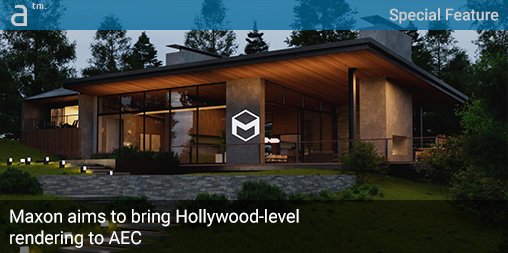DESPITE BEING RENOWNED IN HOLLYWOOD, Maxon and its highly respected Cinema 4D have long been absent from the mainstream accessible real-time rendering tool market for AEC. It is not that architects have no knowledge of Cinema 4D—many do! However, if they are familiar with it, one of three things seems to hold true. They are architects who specialize in visualization, or they are architects who rely on a visualization agency or studio that specializes in Cinema 4D, or they are architects in Europe, where Cinema 4D is far more recognized than in North America.
Maxon aims to change all of this.
A Major Front in Real-Time
The way to change the status quo about Maxon’s presence in the AEC market is to go towards the mainstream, accessible real-time rendering market (ART-RM, pronounced Artem) for architecture. This is the market filled with tools like Twinmotion, Lumion, and Enscape. All these tools are relatively easy-to-use, real-time rendering solutions that typical architects can master to achieve very nice results at a reasonable level of time and effort.
What we want to do now is build that bridge, go into the architect’s firm directly into their hands.
“If you look at the Italian market, or the Japanese market, or the German market, there’s a lot of high-end architectural visualization stories being told in Cinema 4D,” says David McGavran, CEO of Maxon. “That’s usually when the architect passes it onto another production house to do something really special. That’s where we tend to come in.”

Maxon’s new real-time rendering technology is based on its acclaimed Redshift Renderer. The company aims to compete head-on with market leaders in real-time AEC rendering including those like Epic and Chaos.
“What we want to do now is build that bridge,” adds McGavran, “go into the architect’s firm directly into their hands,” McGavran adds that over the years, this is what Maxon has been doing with certain acquisitions.
The Redshift Advantage
While Twinmotion uses its famous Unreal Engine for its rendering technology, which is gaming technology, nobody in the industry has pushed for real-time rendering with technology that is more associated with Hollywood-level visual imagery. Perhaps the exception would be Chaos.
“Redshift is currently the fastest GPU render on the market for full production capability, highest fidelity and highest quality,” adds McGavran. “And we want to take that technology, make it faster, and bring it to more customers.”
Through the new plugin for Vectorworks, users will have access to a separate Maxon rendering window that updates in real-time as users move the model or scene around in the Vectorworks viewport. The user can then complete the scene by utilizing the Redshift render objects and materials that ship with the solution. And those materials look fantastic. (see rendering examples in this article).
McGavran adds that architects can still take these new 3D scenes out to Cinema 4D. So if they want to do a lot of still renderings but leave animation to a visualization studio they work with already using Cinema 4D it is as simple as a click of a button.

Maxon acquired Laubwerk for 3D plant assets earlier in the year. Laubwerk has always led the market in astoundingly realistic and versatile digital plant technology. These assets will be combined as part of the new solution first demonstrated in Vectorworks in June.
McGavran notes that an advantage Maxon will have over its AEC rendering rivals is that of continuity across applications, from between design and BIM apps all the way out to the highest-level rendering and animation in Cinema 4D with Redshift render technology. “You don’t have to restart over with you scene,” he says, “not having to go to different sets of assets, different types of materials, and switching from one renderer to another, which is what the industry standard is today.”
“So if you were to use some of the tools on Earth today, you can’t work within the CAD experience and then go to another toolset without having to do some sort of transition, some sort of translation,” he adds. “And Cineware, which is Maxon 3D technology, has been running inside of Vectorworks, Archicad, and Allplan for the better part of 20 years.”
McGavran’s comments are mostly true as the leading rival to the Nemetschek Group is Autodesk. And while Autodesk is no doubt the industry global leader on the design application side of global AEC, and while it too also has its own Hollywood-level rendering technology, that is not the real-time rendering technology deployed inside of leading tools in architecture like Revit. Instead, Autodesk partnered with Epic and its Twinmotion application inside of Revit.
Since Maxon intends on targeting not just Nemetschek Group BIMs but also Trimble’s SketchUp, Autodesk’s Revit and probably McNeel’s Rhino, all eventually, the company is really competing with Chaos with its family of real-time and non-real-time renderer applications. McGavran said unlike Enscape with its attendant rendering window, in Maxon’s solution you can add and edit the scene in the Maxon window or the host design client’s window. “Anything you put in our viewer-renderer window will be stored in the CAD model or BIM model as well,” he adds, “so it will be bi-directional.”
We want to bring out technology to every creator in the world who is creating compelling stories.
This means you could drag a Maxon solution asset like a tree into the Maxon render-viewer and it would be reflected back in the CAD-BIM scene, “in the correct proxy style that you would expect in Vectorworks,” he adds. With Maxon’s acquisition of Laubwerks it means you drag their higher resolution versions of their trees into the Maxon viewer and the lower resolution version of the tree shows in the Vectorworks window.
Moving to Cinema 4D
Cinema 4D has always been an excellent advanced digital content creation (DCC) software tool but generally too complex for architects to jump directly into. McGavran says there will be a simple button to push out from their Maxon solution directly to Cinema 4D. This would enable visualization studios or dedicated archviz specialists to further advance the project’s renderings and animations. “The advantage is you will be able to continue in Cinema 4D without another transition happening,” adds McGavran, who notes that will be a distinguishing feature of their solution in the market.
In some ways this strategy isn’t just elevating the capabilities of its sister brands in Vectorworks, Archicad, and Allplan, it ultimately provides more market drive to Cinema 4D itself. It is not that Cinema 4D is so advanced that regular architects can’t use it—far from it—it just takes dedicated time in the app. Yet McGavran wants non-Nemetschek brands to experience Maxon technology as well.
“We want to bring out technology to every creator in the world who is creating compelling stories.” So on that note one can expect Maxon to target some of the most popular design tools in architecture rather quickly, including those outside its sister brands. At this point though there are no comments on timelines for Maxon’s overall AEC real-time visualizations strategy.
New Maxon Technology at AIA Boston
Maxon will be showcasing their new real-time rendering plugin-based technology at AIA Boston in early June. Visitors to the Vectorworks booth can see it demoed live.



